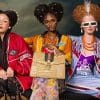In an exclusive video for BAZAAR.com, filmed in collaboration with the Model Alliance, 10 brave models open up about their personal experiences of sexual harassment and assault in the fashion industry, for a long-awaited reckoning on their own terms. Their next challenge: ending sexual violence in the global fashion industry—for good.
In fashion, you could be in a room with six abusers at once. They’re all covering each other’s backs,” reveals veteran casting director James Scully. “Unfortunately that’s why I had to start calling people out, and will continue to do so if I have to, because that was the only way to break the cycle.”
Scully, a former bookings editor at Harper’s Bazaar and an advisory board member of the Model Alliance, became known as the modeling industry’s whistle-blower after he publicly accused Lanvin and Balenciaga for mistreatment of a non-sexual nature earlier this year (Balenciaga responded swiftly, promising to make radical changes to its casting process, meanwhile Lanvin called Scully’s allegations “completely false and baseless”). Today, he’s sitting in a lecture room at Columbia University surrounded by models, casting directors, fashion writers and activists, for a Model Alliance-hosted strategy session on how to end sexual violence in the global fashion industry.
“This business needs a cleansing out. It’s time to hit the reset button,” continues Scully, who has worked with designers such as Carolina Herrera, Tom Ford, Gucci and Stella McCartney. “Like sweatshops, the fashion industry has become so flooded with girls and boys that they lost their power to people who hijacked the business. It has become a power play and a bully play.”
Thanks in large part to the support of the Model Alliance, and the thousands of women who have come forward with their own stories of sexual harassment and assault under the #MeToo movement, models are finally flipping the power dynamic for a reckoning on their own terms.
Trigger warning ⚠️ #MyJobShouldNotIncludeAbuse
A post shared by Cameron Russell (@cameronrussell) on
Not long after Harvey Weinstein was accused of sexual assault in investigations published in The New York Times and The New Yorker, model Cameron Russell began posting anonymous stories from fellow models of their experiences on her Instagram account, with the hashtag #MyJobShouldNotIncludeAbuse. Models Amber Valletta, Kate Upton, Elsa Hosk, Sara Sampaio, and Karen Elson—also an advisory board member of the Model Alliance—quickly followed suit, sharing wrenching stories from both women and men in the industry.
“Sexual respect starts at the top,” says model and Model Alliance founder, Sara Ziff, who, since 2012, has fought for fair treatment and equal opportunity in the fashion industry. Ziff started modeling at 14 years old, and recalls on one of her first castings, she was sent to a photographer’s studio apartment by herself. “There were other models in the stairwell but we were told to wait and just go in one by one, so we were alone with him,” remembers Ziff. “He said, ‘Can I see you without your top?’ I was like, ‘Sure, yeah okay.’ Then he asked, ‘Can I see you without your pants?’ So I’m standing there in Mickey Mouse underwear and a sports bra and he’s like, ‘Well, I need to see you without your bra.’ I just assumed, here’s this adult in this position of authority who I’m supposed to be listening to, so I went along with every request. That was one of many such experiences that are all too common in our industry. Twenty years later, I’ve since dedicated myself to work to address models’ lack of legal protection against sexual harassment and to foster a culture of accountability in the fashion industry.”
Modeling agencies claim to act in an advisory capacity as management companies, instead of talent agencies, and models in the U.S.—unlike actors—are generally considered independent contractors, which leaves them vulnerable to sexual harassment in the workplace. (The Model Alliance, with the support of New York State Assemblywoman Nily Rozic, introduced an amendment to the state’s current anti-discrimination laws, called the Models’ Harassment Protection Act, last month, and hope to see it become law next year.) “If there aren’t protections in place that clarify where legal liability for job-related sexual harassment lies, then women—and men—cannot know or fully exercise their rights, and real change will not occur,” says Ziff, who believes modeling agencies should not be allowed to turn a blind eye to abuse, and should work with reputable experts to implement protective policies and procedures.
“This business needs a cleansing out. It’s time to hit the reset button.”
“At most it seems the agencies will say to the model, ‘Well, if you’re in an uncomfortable situation, then you can always just say no.’ But it’s easier to say that than be the young girl in that situation, dealing with a powerful stylist, editor, or photographer who can make or break her career,” explains Ziff. “Working as a model requires being able to be spontaneous and creative—to work with people in the moment—and there is pressure to be compliant and easy to work with. So inappropriate requests can come out of nowhere, and they can also be a continuation of something that would otherwise be pretty normal. Both are tricky to navigate.”
Add that models may not be given any guidelines about what is inappropriate behavior on a photoshoot, says New York-based Dominican model, Yaris Cedano, and it’s not surprising models find themselves confused as to what is considered a “normal” request from a photographer. Often, models are expected to change in front of dozens of people on photo shoots (including the photographer, hair and makeup artists, stylists and photo assistants), yet models routinely silence their own discomfort because they don’t want to appear difficult. It is also not uncommon for a shoot’s art direction to involve nudity. Such requests, however, are supposed to be discussed with, and approved by, the model prior to arriving on set.
“You know, it’s rare that you feel a bad vibe right away,” explains Cedano. “You can like this person so much: ‘Wow, how polite, how nice is this photographer,’ and then when they ask for something inappropriate, you feel weird. You think, how can I not trust this person when he has been so nice through these three hours? The fashion industry is based on the idea that sex sells, that sex is really cool. We need to have conversations that make it like, sex sells and sex is great, but sexual assault and sexual harassment isn’t.”
For one Australian model who began her career at 18 years old, the lack of information and resources is a widespread issue—as is the tendency for modeling agencies to turn a blind eye. “No conversation was ever spoken to me about what’s appropriate and inappropriate,” says the model, who was unable to give her full name for legal reasons. “I was sent to certain photographers that I found out, years later, were notorious for bad behavior. My agents never warned me. They just said, ‘This person’s really important so be sexy, dress well.’ Agencies should not be sending their girls to these people. They know, and they have been looking away.”
A post shared by Karen Elson (@misskarenelson) on
Often, it is actually the agencies who push models to stay quiet about inappropriate experiences. “I hear from a lot of other models that [their agents] just say ‘Oh, don’t be too loud because that guy has a really good name and that photographer might be able to use you in a campaign later. He’ll remember your name,'” says Cedano. “So you think, great, I have to be quiet about it.”
With no human resources department to turn to, and because models aren’t unionized (“We’re told we’re independent contractors, so we can’t engage in collective bargaining,” says Ziff), models frequently view the press as their only recourse, but as Scully points out, that can backfire.
“It’s very hard for people to speak out because at the end of the day, it’s a big risk,” Scully admits. “A lot of girls had spoken out against Terry [Richardson], and they lost their careers. Now, it’s burning itself for what it is, but in the end, what happens to all the people [who spoke out] before? I find it frustrating that everyone’s saying, why did it take 25 years? Well that’s why it took 25 years for these women in Hollywood to come out.” (Terry Richardson continues to “adamantly” deny recent allegations of sexual assault, and has maintained that any sexual activity with models was consensual.)
“We need to have conversations that make it like, sex sells and sex is great, but sexual assault and sexual harassment isn’t.”
Scully goes on to describe the fashion and entertainment industries as a “pay to harass” system, which enables powerful photographers and directors to escape economic accountability. “The harassers don’t have to pay. The companies basically get insurance, so the insurers pay. The insurers, interestingly enough, don’t seem to force the abusers in the companies into any particular compliance. It’s just a matter of if they can get the non-disclosure agreement, everybody is good. So the fact that there’s payouts doesn’t change anything because you can pass on the cost to the consumers—it’s just all part of business. They kind of figure in the cost of sexual harassment into the actual making of the product.” If it’s currently cheap to exploit people, then one answer is to make it expensive, suggests Scully.
It’s becoming clear that solidarity—across all sectors of the fashion industry, from models and stylists, to writers and designers—is crucial to a better-regulated fashion industry. Earlier this month, the luxury fashion groups Kering (which owns Gucci, Saint Laurent and Balenciaga) and LVMH (which owns Louis Vuitton, Christian Dior and Celine) propagated a new Models’ Charterthat they hope other companies will adopt. “We want to be at the heart of a movement and to bring everyone together,” Marc-Antoine Jamet, secretary-general of LVMH, told WWD.
Ziff has also called for a neutral third party program, which would work constructively with businesses and industry groups that publicly commit themselves to ensuring safe and fair working conditions. It would also develop a code of sexual respect and best practices, creating protocols for filing complaints, conducting investigations, and ensuring positive change in the fashion industry. Key, says Ziff, is that company codes are enforced, and that the best monitors of sexual harassment and other workers’ rights are the workers themselves. “In an industry that’s essentially built on the backs of women and girls, who are all trying to have a voice in their work, it’s powerful to join together,” says Ziff. “The fashion industry now has an opportunity not only to solve these issues for itself, but also to be a model for other industries.”
The Model Alliance, a nonprofit organization, promotes fair treatment, equal opportunity, and sustainable practices in the fashion and modeling industries, from the runway to the factory floor. By assisting models and other stakeholders in understanding the laws applicable to them, and by encouraging them to have a voice in their work, Model Alliance identifies common areas of concern in the fashion industry, conducts strategic research with leading research institutions, and educates the industry and the public about core issues. To donate, please click here.
From: Harper’s BAZAAR US



